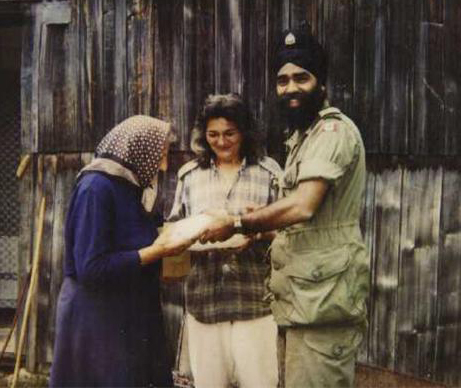
On Feb. 6, Minister of National Defence Harjit Sajjan travelled to Washington to meet with U.S. Secretary of Defense James Mattis to discuss NORAD, NATO and Canada-US relations forged on the battlefield. [Twitter]
Strict rules of engagement—preventing peacekeepers from firing unless fired on, for example—endangers blue-helmeted troops and limits their effectiveness.
Minister of National Defence Harjit Sajjan, a decorated military veteran who was wounded on duty in Bosnia and did three tours in Afghanistan, doesn’t dispute the impressions of his former colleagues.
“You’ve got to look at how peacekeeping started,” he said in an interview with Legion Magazine. “It was designed for a particular set of security challenges where peace agreements were signed by both parties and you have this intervening force coming in between to enforce that peace.
“Over time, as conflicts changed, they weren’t evaluated as thoroughly as they could have been, which created [new] challenges. The right rules of engagement weren’t there; the chain of command function in terms of authority was not there.”
Last year, the federal government announced it would commit up to 600 troops to UN peace-support operations, but a decision was delayed following the surprise election of Donald Trump to the White House.
Trump’s ambassador to the United Nations, Nikki Haley, has made peacekeeping reform a top priority. The Americans spend nearly US$8 billion annually on peacekeeping missions and Haley has said she wants to look at all 16 U.S. missions to see which are succeeding in maintaining peace and which are not. Trump has said American taxpayers spend far too much on other countries’ security.
Sajjan, meanwhile, met with his American counterpart, retired marine general James Mattis, on Feb. 6. The minister and the defence secretary discussed continental defence as well as multilateral issues. Those included both countries’ pledges to lead NATO battle groups in Eastern Europe and UN operations.
But the question of where and when those UN commitments will be fulfilled remained unanswered immediately following the discussion. Before November’s U.S. election, Canada was considering sending troops to Mali.
“We are still doing our homework,” said Sajjan’s spokeswoman, Jordan Owens.
“Minister Sajjan wanted to have a conversation with the new U.S. administration about ways both our nations can work within the UN framework to increase peace and stability around the world.”
Wherever it ends up, rest assured the mission will be conducted differently compared to many of its predecessors. Gone, in many cases, are the days of two sides, a line and the formalities of diplomacy.
The factors involved are ever-more complex and it’s not fair to the troops to send them into situations that haven’t been thoroughly assessed, said Sajjan.
Times have indeed changed, he said, and there is no one-size-fits-all solution to peacekeeping challenges. Canada’s diversity and world view are ideally suited to the demands of modern-day peace-support operations, he said.

Captain Harjit Sajjan poses with a displaced Bosnian woman and a UN worker in 1998. Sajjan won an award for humanitarian efforts in Bosnia. [Handout-Canada]
Robust rules of engagement are needed, yes, but so is flexibility for commanders on the ground and the ability to make quick decisions for the safety and security of civilians.
Canada’s innovative approach to peacekeeping is not limited to military options, either, he added. Several government departments are involved and assessments are based on where Canadians can make the most impact with finite resources.
In Africa, for example, poverty and a preponderance of vulnerable youth who don’t see hopeful futures are major factors in the recruitment and development of extremists. “If we don’t give them a future, they’re going to find some other things to do and, regrettably, they’re going to be sucked into the extremist propaganda.”
The military gets most of the attention but it actually plays a supporting role in many peace-support operations, said Sajjan. “We want to bring innovative solutions that are going to move the yardstick forward and help improve the efficiency and solve some of the problems that have marred the United Nations in the past.”
This is the second of two articles based on an interview with Defence Minister Harjit Sajjan. To read part 1—on NATO’s role—CLICK HERE.
Advertisement






















